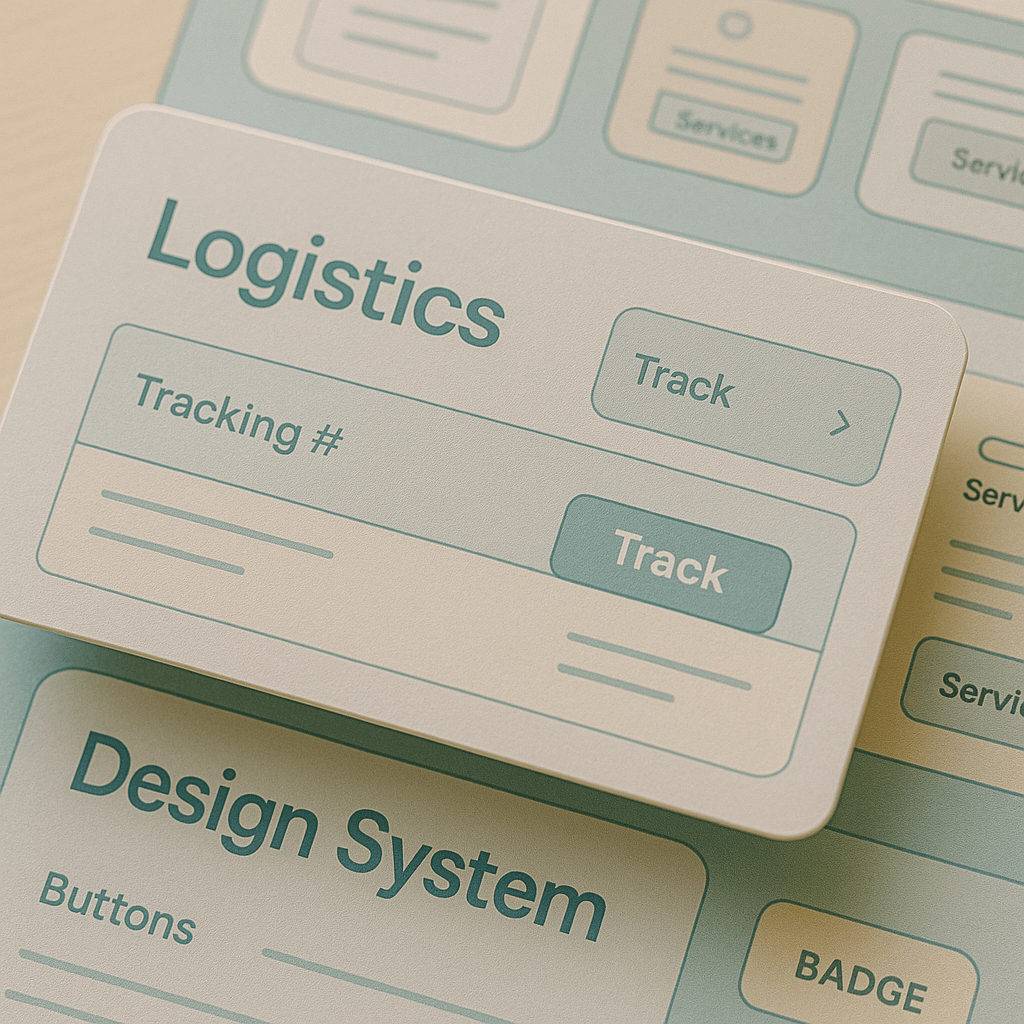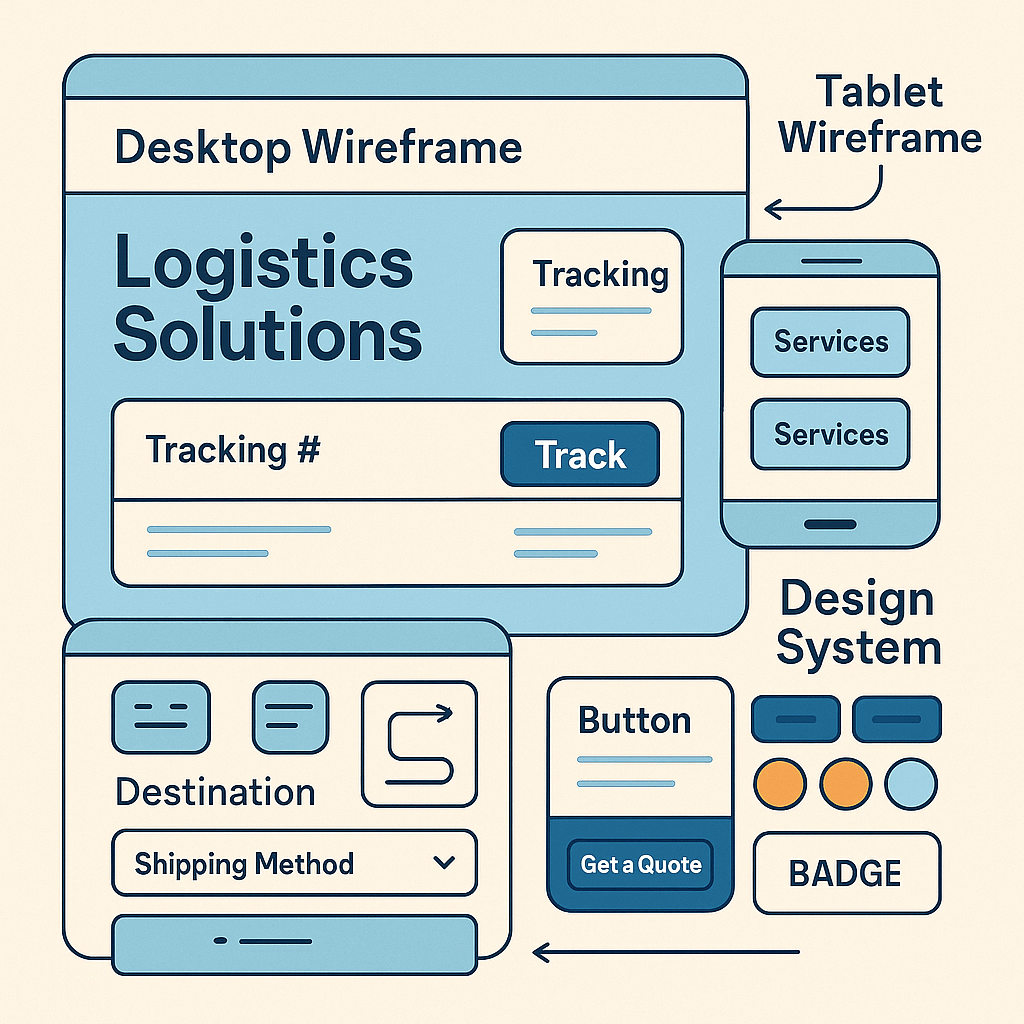Why Logistics Companies Use Web Design
by Design Delulu Editorial · September 10, 2025

In today's digital-first economy, logistics companies face unprecedented challenges in managing complex supply chains while meeting rising customer expectations. From real-time tracking demands to seamless communication across multiple touchpoints, the logistics industry requires more than just efficient operations—it needs a strong digital presence that can handle the complexity of modern commerce.
Web design has emerged as a critical business tool for logistics companies, transforming how they interact with clients, manage operations, and scale their services. Far from being just an online brochure, a well-designed website serves as the central nervous system of a logistics operation, connecting customers, partners, and internal teams through intuitive digital experiences.
Why Logistics Companies Need Web Design

Key Challenges They Face
Transparency and Visibility Demands
Modern customers expect real-time visibility into their shipments, delivery timelines, and potential delays. Without proper digital infrastructure, logistics companies struggle to provide the transparency that builds trust and loyalty.
Complex Communication Networks
Logistics involves multiple stakeholders—shippers, receivers, carriers, customs officials, and warehouse teams. Managing communication across these touchpoints manually creates bottlenecks and increases the risk of errors.
Scalability Limitations
Growing logistics companies often find their existing systems can't handle increased volume without proportional increases in administrative overhead. Manual processes that work for dozens of shipments become unsustainable for hundreds or thousands.
Competitive Differentiation
In a market where many logistics providers offer similar services, companies struggle to communicate their unique value propositions and specialized capabilities to potential clients.
How Web Design Solves These Problems
Strategic web design addresses these challenges by creating digital solutions that streamline operations while enhancing customer experience:
- Automated Information Systems: Well-designed websites integrate with logistics management systems to provide real-time updates, automated notifications, and self-service portals that reduce the burden on customer service teams.
- Centralized Communication Hubs: Modern web design creates unified platforms where all stakeholders can access relevant information, submit requests, and track progress, eliminating the confusion of scattered communication channels.
- Scalable Digital Infrastructure: Properly designed websites grow with the business, handling increased traffic, more complex service offerings, and expanded geographic coverage without requiring complete overhauls.
- Brand Positioning and Trust Building: Professional web design establishes credibility, communicates expertise, and builds trust with potential customers who increasingly research logistics providers online before making decisions.
Essential Features of Web Design for Logistics Companies

Must-Have Tools and Design Elements
Real-Time Tracking Integration
The cornerstone of modern logistics web design is seamless integration with tracking systems. This includes interactive maps, status updates, estimated delivery times, and proactive notification systems that keep customers informed throughout the shipping process.
Customer Portal Functionality
Self-service portals allow customers to schedule pickups, generate shipping labels, access invoices, and manage their account preferences. This reduces administrative workload while providing customers with 24/7 access to essential services.
Mobile-Responsive Design
Given that logistics operations happen around the clock and across various locations, mobile optimization is crucial. Drivers, warehouse staff, and customers all need access to information and functionality from mobile devices.
Quote and Booking Systems
Automated quoting tools that consider factors like distance, weight, delivery timeline, and special requirements help customers get instant pricing while qualifying leads for the sales team.
Document Management
Secure portals for uploading and accessing important documents like bills of lading, customs forms, and delivery confirmations streamline operations and ensure compliance.
Real-World Examples
Leading logistics companies demonstrate these principles in action. FedEx's website seamlessly integrates tracking with location services, allowing customers to see exactly where their package is and when it will arrive. UPS goes further by offering comprehensive business solutions through their online platform, including shipping calculators, pickup scheduling, and inventory management tools.
Regional logistics companies can implement similar functionality on a smaller scale. A local freight company might integrate with GPS systems to provide real-time truck locations, while a specialized logistics provider could offer industry-specific tools like temperature monitoring for pharmaceutical shipments.
Common Mistakes to Avoid

Typical Pitfalls in Web Design for Logistics Companies
Information Overload
Many logistics websites try to showcase every service and capability on their homepage, creating cluttered experiences that overwhelm visitors. This approach fails to guide users toward relevant information and can actually reduce conversion rates.
Neglecting Mobile Users
Some logistics companies focus heavily on desktop experiences while underestimating mobile usage. In reality, many logistics decisions are made on mobile devices, particularly by drivers and field staff who need quick access to information.
Poor Integration Planning
Building websites that don't integrate with existing logistics management systems creates data silos and forces staff to manage multiple platforms manually. This defeats the purpose of digital transformation.
Ignoring Loading Speed
Logistics websites often handle large amounts of data and complex functionality. Without proper optimization, these sites can become slow and frustrating, particularly for users in areas with limited internet connectivity.
How to Do Better
- Prioritize User Journey Mapping: Understand how different users interact with your services and design pathways that make sense for each user type. A shipper looking for quotes has different needs than a receiver tracking a package.
- Implement Progressive Disclosure: Present information in layers, showing the most important details first and allowing users to drill down for more specifics. This approach keeps interfaces clean while ensuring comprehensive information remains accessible.
- Plan Integration from the Start: Work with developers who understand both web design and logistics systems to ensure seamless data flow between your website and operational tools.
- Optimize for Performance: Implement content delivery networks, optimize images, and use efficient coding practices to ensure fast loading times across all devices and connection types.
SEO and Growth Best Practices
Optimization Tips Specific to Logistics Companies
- Local SEO Focus: Many logistics companies serve specific geographic regions. Optimize for local search terms like "freight shipping Chicago" or "logistics services Texas" to capture regional business opportunities.
- Service-Specific Landing Pages: Create dedicated pages for different logistics services (warehousing, distribution, freight brokerage) with targeted keyword optimization and detailed service descriptions.
- Content Marketing Strategy: Develop valuable content around logistics challenges, industry trends, and best practices. This positions your company as an industry expert while improving search engine rankings.
- Technical SEO for Tracking Pages: Ensure that tracking and customer portal pages are properly optimized and indexed, as these often receive high traffic volumes and can serve as entry points for new customers.
Leveraging Web Design for Visibility and Results
- Conversion Optimization: Design clear conversion paths that guide visitors from initial interest to quote requests or service inquiries. Use analytics to identify drop-off points and continuously improve the user experience.
- Social Proof Integration: Showcase client testimonials, case studies, and industry certifications prominently throughout the site to build trust and credibility with potential customers.
- Performance Monitoring: Implement robust analytics to track not just website traffic, but business outcomes like quote requests, customer portal usage, and customer satisfaction scores.
- Continuous Improvement: Web design for logistics companies should evolve based on user feedback, operational changes, and industry developments. Plan for regular updates and enhancements rather than treating the website as a one-time project.
The Future of Logistics Web Design
The logistics industry continues to evolve rapidly, with emerging technologies like IoT sensors, blockchain tracking, and AI-powered route optimization creating new opportunities for web-based solutions. Companies that invest in robust, scalable web design today position themselves to integrate these technologies seamlessly as they become mainstream.
Moreover, as sustainability becomes increasingly important to customers, logistics websites will need to communicate environmental initiatives, carbon footprint calculations, and eco-friendly shipping options effectively.
The most successful logistics companies will be those that view their website not as a marketing afterthought, but as a core operational tool that enhances efficiency, improves customer satisfaction, and drives sustainable growth.
Ready to transform your logistics operation with strategic web design? Modern logistics demands more than just moving packages—it requires digital infrastructure that can scale with your business and exceed customer expectations. Professional web design creates the foundation for operational efficiency, customer satisfaction, and sustainable growth in an increasingly competitive market.
👉 Explore Design Delulu's Web Design Services to discover how strategic design can revolutionize your logistics operations and drive measurable business results.